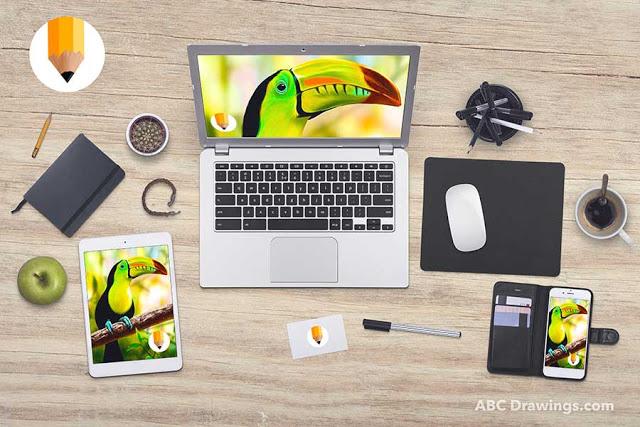Happy Holidays! Are you ready to have fun? Today we are going to learn about how to draw a gingerbread man, step-by-step.
In this lesson you will learn about graphic design and how to use basic geometric and organic shapes to create your artwork. You will also learn about sketching, colored pencil and crayon techniques...and you can even get to combine them all! It's called: mixed media technique. By doing this lesson you will be able to:
Step 1. Paper Orientation: Place the paper in the portrait position.
Step 2. Sketch with Geometric Shapes: Use geometric shapes to properly position the subject (foreground) within the available space (background).
Step 3. Sketch with Organic Shapes: Use organic shapes to add forms and areas that better resemble the subject we are going to draw and paint about.
Step 3. If Necessary, Erase and Sketch Again: Use an eraser to carefully eliminate lines that are no longer necessary or lines that are not properly representing the subject matter. Softly sketch again or retrace until you are happy with the structure or basic forms and shapes that will later need to be colored or painted.
Step 4. Darken Up: Use darker lines or color to identify the shapes and forms that better represent the subject matter.
"Backyard Birds, Holiday Treats"
William Vanderdasson, is a very creative and successful illustration artist who has painted scenic landscapes, wildlife and sport images. His illustrations have been used on greeting cards, wrapping paper, and multiple other products with overwhelming success.
You can get to learn a lot just by looking at an artist artwork. Here's a very easy guide to assist you in the process of learning while enjoying the artist's work.

This amazing software also allows you to export a time-lapse video of the entire process of art creation, which is indeed a very useful tool for both art teachers and students.

- Create geometric and organic shapes as the foundation for any design
- Understand and apply the elements and principles of design
- Understand and apply creative techniques to develop your work
- Connect with other subjects, read, write and utilize higher order thinking skills
GRAPHIC DESIGN: LESS IS MORE!
This art project belongs to a very fun art category: graphic design. Graphic design artists or graphic designers, work really hard to make sure the convey a message or an idea through their art in a very quick, efficient and beautiful way.
DRAW & LEARN
In the process of creating your artwork, you will also learn about the Elements and Principles of Design, marine life and get to do some cool science and writing activities. Follow our step-by-step tutorial video and have fun drawing your own toucan. When you finish, don't forget to take pictures of it and share your amazing artwork.SAFETY FIRST!
Make sure you have set up your art supplies and different materials in a safe, uncluttered area with adult supervision. For parents and students, we strongly recommend using YouTube Kids » to safely browse and watch videos on mobile devices or desktop.ELEMENTS & PRINCIPLES OF DESIGN
Elements: Line, Shape, Space, Color, Form, Texture, Value. Principles: Balance, Unity, Variety, Emphasis, Movement, Pattern, Proportion.
Form, Texture, Value. Principles: Balance, Unity, Variety, Emphasis, Movement, Pattern, Proportion.
Form, Texture, Value. Principles: Balance, Unity, Variety, Emphasis, Movement, Pattern, Proportion.
GENERAL INSTRUCTIONS & PROCESS
Start off by sketching geometric and organic shapes. Then move on to adding details and color. If you wish, erase the original guiding or sketching lines. Using the Elements and Principles of Design go ahead and have fun drawing and coloring.
Step 1. Paper Orientation: Place the paper in the portrait position.
Step 2. Sketch with Geometric Shapes: Use geometric shapes to properly position the subject (foreground) within the available space (background).
Step 3. Sketch with Organic Shapes: Use organic shapes to add forms and areas that better resemble the subject we are going to draw and paint about.
Step 3. If Necessary, Erase and Sketch Again: Use an eraser to carefully eliminate lines that are no longer necessary or lines that are not properly representing the subject matter. Softly sketch again or retrace until you are happy with the structure or basic forms and shapes that will later need to be colored or painted.
Step 4. Darken Up: Use darker lines or color to identify the shapes and forms that better represent the subject matter.
Step 5. Coloring or Painting: Use your desired art materials or supplies to begin coloring or painting the different areas. Make sure you use strokes that go along with the anatomical sections of the subject and the background. Add mid tone values first, then dark tone shades. Highlights will always be the last set of tones, value and shades that you will add to any section.
GENERAL INSTRUCTIONS & PROCESS
Start off by sketching geometric and organic shapes. Then move on to adding details and color. If you wish, erase the original guiding or sketching lines. Using the Elements and Principles of Design go ahead and have fun drawing and coloring.
Step 1. Paper Orientation: Place the paper in the portrait position.
Step 2. Sketch with Geometric Shapes: Use geometric shapes to properly position the subject (foreground) within the available space (background).
Step 3. Sketch with Organic Shapes: Use organic shapes to add forms and areas that better resemble the subject we are going to draw and paint about.
Step 3. If Necessary, Erase and Sketch Again: Use an eraser to carefully eliminate lines that are no longer necessary or lines that are not properly representing the subject matter. Softly sketch again or retrace until you are happy with the structure or basic forms and shapes that will later need to be colored or painted.
Step 4. Darken Up: Use darker lines or color to identify the shapes and forms that better represent the subject matter.
Step 2. Sketch with Geometric Shapes: Use geometric shapes to properly position the subject (foreground) within the available space (background).
Step 3. Sketch with Organic Shapes: Use organic shapes to add forms and areas that better resemble the subject we are going to draw and paint about.
Step 3. If Necessary, Erase and Sketch Again: Use an eraser to carefully eliminate lines that are no longer necessary or lines that are not properly representing the subject matter. Softly sketch again or retrace until you are happy with the structure or basic forms and shapes that will later need to be colored or painted.
Step 4. Darken Up: Use darker lines or color to identify the shapes and forms that better represent the subject matter.
Step 5. Coloring or Painting: Use your desired art materials or supplies to begin coloring or painting the different areas. Make sure you use strokes that go along with the anatomical sections of the subject and the background. Add mid tone values first, then dark tone shades. Highlights will always be the last set of tones, value and shades that you will add to any section.
GET INSPIRED!
Look for inspiration in the works of this amazing artist:
Happy December 1st Twitter!
— artGalore (@artgalore) December 1, 2019
📸Backyard Birds, Holiday Treats
by William Vanderdasson on https://t.co/R5yl2HstsV! pic.twitter.com/Qr95iopjTN
William Vanderdasson, is a very creative and successful illustration artist who has painted scenic landscapes, wildlife and sport images. His illustrations have been used on greeting cards, wrapping paper, and multiple other products with overwhelming success.
You can get to learn a lot just by looking at an artist artwork. Here's a very easy guide to assist you in the process of learning while enjoying the artist's work.
ART APPRECIATION: THE FELDMAN'S MODEL OF ART CRITICISM
1. DESCRIPTION: Describe what you see. What is the artwork depicted all about?
2. ANALYSIS: Elements and Principles of Design. How does the artist uses them all
3. INTERPRETATION: What is the content or meaning? What does it mean to you?
4. JUDGMENT: How original is the work? Do you like it? Why?
2. ANALYSIS: Elements and Principles of Design. How does the artist uses them all
3. INTERPRETATION: What is the content or meaning? What does it mean to you?
4. JUDGMENT: How original is the work? Do you like it? Why?
GET IT PRINTED!
There are plenty of printing companies out there who do an amazing job at turning any graphic design project into real masterpieces.
WHERE?
You can use a printer or have it uploaded to many of the websites companies who specialize in photography, art or graphic design printing services.
VOCABULARY WORDS
- habitat
- shelter
- environment
- organism
PROCREATE®
I use Procreate® to digitally draw and paint the artworks for most of my art lessons. It's a very easy to use iPad application that also allows me to keep tabs of the very different steps I take in the process of art creation.
This amazing software also allows you to export a time-lapse video of the entire process of art creation, which is indeed a very useful tool for both art teachers and students.
KEEP ON LEARNING
Distance, online learning is as important as learning in the classroom. Stay connected, follow us and subscribe! Keep on learning!REFERENCES
TEXAS EDUCATION AGENCY (TEA) For more information please visit 19 TAC Chapter 117. Texas Essential Knowledge and Skills for Fine Arts (TEKS). Learn more »




